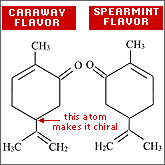Your Nose Knows!
 Would you like spearmint or caraway flavor? That's a strange choice, but believe it or not, they are the same thing. Well, almost. Spearmint and caraway both contain a molecule called carvone with the empirical formula C10H14O, or rather 10 carbon atoms, 14 hydrogen atoms, and 1 oxygen atom. The thing that makes them taste different is that one is left-handed and the other is right-handed. In order for something to have a left or right-handedness, it must be chiral.
Would you like spearmint or caraway flavor? That's a strange choice, but believe it or not, they are the same thing. Well, almost. Spearmint and caraway both contain a molecule called carvone with the empirical formula C10H14O, or rather 10 carbon atoms, 14 hydrogen atoms, and 1 oxygen atom. The thing that makes them taste different is that one is left-handed and the other is right-handed. In order for something to have a left or right-handedness, it must be chiral.
Chiral molecules contain the same atoms arranged as mirror images that are non-superimposable. Examples of chiral objects are your hands. Your left hand is the same as your right hand, but they are not interchangeable. Your right hand cannot be replaced by your left hand just as you cannot put your left glove on your right hand. In fact, if you look at your right hand in the mirror, the image you would see would be a left hand. They are mirror images of each other that are non-superimposable; therefore they are 'chiral'. Superimposable objects are things such as balls, cubes, and baseball bats. They are not chiral. When you look at their reflection in a mirror, it looks just like the actual object.
Chiral things only exhibit differences between right and left-handedness when tested with other chiral things. There is no advantage to picking up a chicken egg with the left hand as opposed to the right, because the egg is not chiral. Similarly, a non-chiral piece of test equipment can't distinguish between caraway or spearmint flavoring. The molecules have the same melting point, molecular weight, density, optical absorption, etc. In order to differentiate them, you need a chiral probe. So how can you tell the difference between them when expensive equipment can't? Your nose is a chiral probe!
About the Author
Willa Larsen, MS
 Willa Larsen writes on a wide array of topics for ScienceIQ. Willa
received a BS in physics from University of Colorado and a MS in
materials science and engineering from UCLA. She previously worked
making infrared detectors for the Hubble, missiles and surveillance
equipment. Willia is the publisher of WillasArk.com which helps fund animal rescue.
Willa Larsen writes on a wide array of topics for ScienceIQ. Willa
received a BS in physics from University of Colorado and a MS in
materials science and engineering from UCLA. She previously worked
making infrared detectors for the Hubble, missiles and surveillance
equipment. Willia is the publisher of WillasArk.com which helps fund animal rescue.


